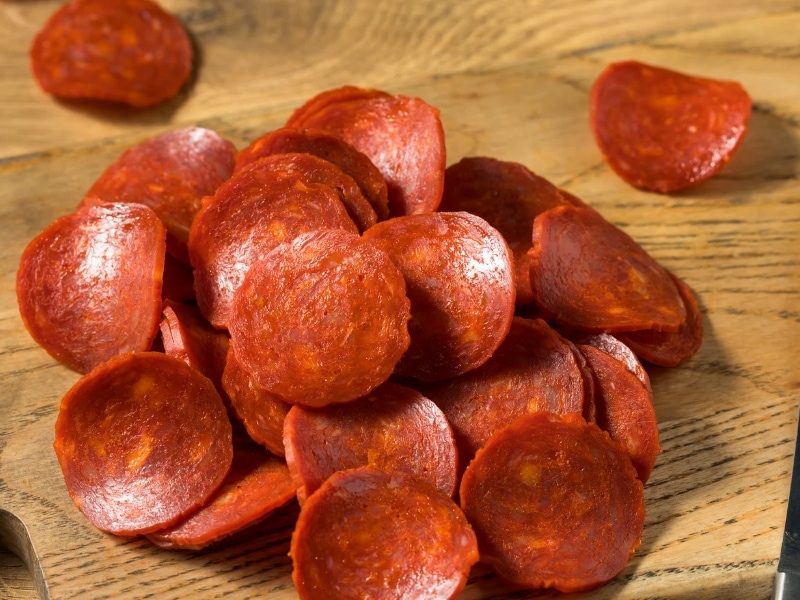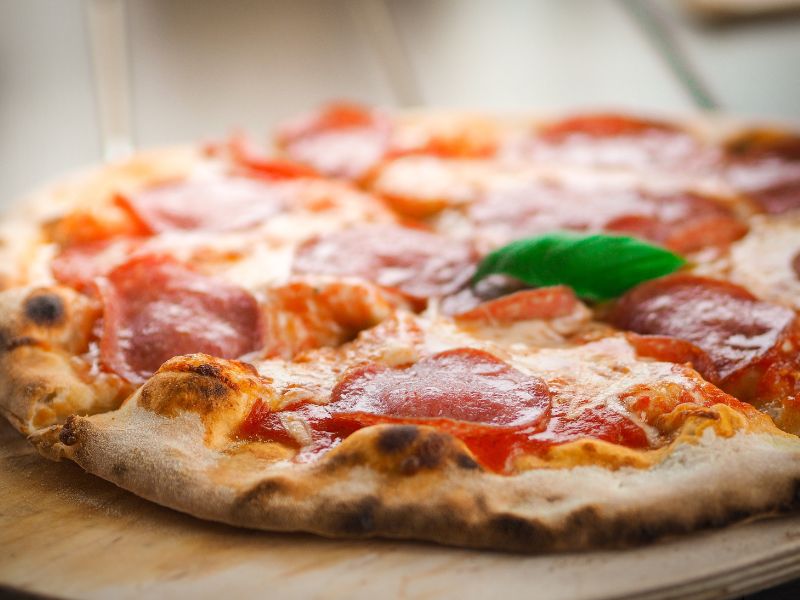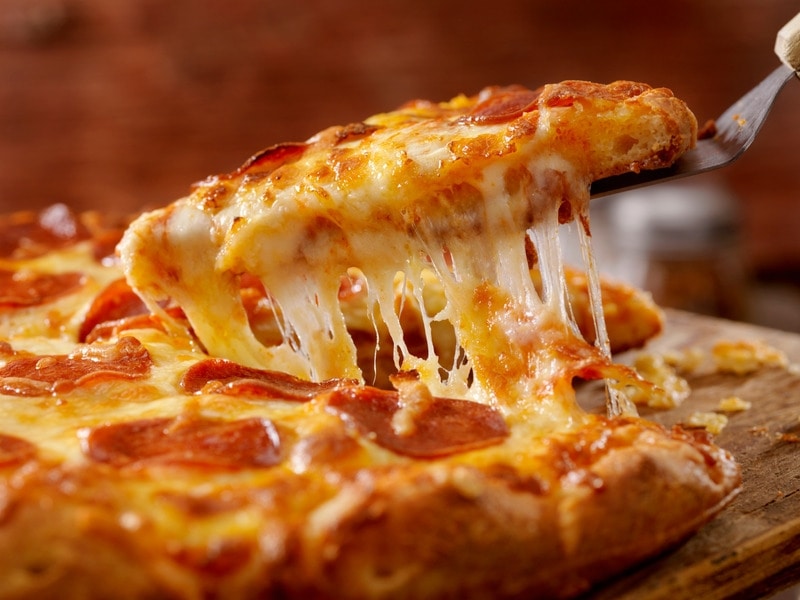Pepperoni originated from Italian immigrants in America, developing into a unique spicy sausage. With origins tracing to the late 1800s, pepperoni combines pork and beef mixed with peppers, garlic, fennel and paprika. It boasts a signature taste that is mildly spicy yet hearty from real meat including pork and beef.
It brings a bold fiery flair to dishes while remaining America’s favorite pizza topping, ordered on over 35% of pies. Its blend of paprika, red peppers and secret spices impart complexity revealed through cooking. As a result, it greatly enhances the aroma and savor of meals from pizza to pasta sauce.
How To Select
It is best to choose pepperoni that is not faded or discolored, indicating it has been sitting on the shelf for an extended time. Furthermore, aiming for a vibrant red hue ensures that it is at its peak quality and flavor.
What Goes Well With
Pizza,Pasta dishes,Cheese boards,Grilled cheese sandwiches,Potato skins,Pepperoni cups,Nachos,Mac and cheese.
What is Pepperoni?
Pepperoni is a type of dry-cured, spicy sausage that originates from Italian-American cuisine. Made from a blend of pork and beef, it is seasoned with a mixture of paprika, garlic, black pepper, and other spices that give it its signature red color and bold taste. Unlike traditional Italian salami, pepperoni has a softer texture, a slightly smoky flavor, and a high-fat content, making it perfect for crisping up on a hot pizza.
The word “pepperoni” comes from the Italian word “peperone,” which means “bell pepper.” However, what we know as pepperoni today was actually developed in the United States in the early 20th century. Italian immigrants in the U.S. adapted their traditional curing methods to create a sausage that complemented American-style pizzas. Since then, pepperoni has become the most popular pizza topping in the U.S. and a staple in many other dishes.
How is Pepperoni Made?
Pepperoni is crafted using a meticulous process that enhances its flavor and texture. The production begins with a mixture of ground pork and beef, blended with spices such as paprika, garlic powder, salt, black pepper, fennel seeds, and cayenne pepper for a kick of heat. The mixture is then stuffed into casings, typically made from natural or collagen-based materials.
Once stuffed, the pepperoni undergoes fermentation and curing. This stage is crucial for developing its characteristic tangy flavor. During fermentation, beneficial bacteria help lower the pH, making the sausage safe for consumption while also adding a unique depth of flavor. The sausages are then smoked to enhance their taste and preserve them further.
Traditional pepperoni is air-dried for several weeks, whereas mass-produced pepperoni undergoes a quicker drying process using controlled temperatures and humidity. This is why commercial pepperoni is softer and has a more uniform appearance compared to artisanal or homemade versions.
Types of Pepperoni
Pepperoni comes in various forms, each offering a different taste and texture experience.
Regular vs. Spicy Pepperoni – Regular pepperoni has a balanced smoky and mildly spicy flavor, while spicy versions include extra cayenne, crushed red pepper, or chili flakes for a fiery kick.
Thick-Cut vs. Thin-Cut – Thin-cut pepperoni crisps up beautifully when cooked, making it ideal for pizzas. Thick-cut pepperoni retains a juicier bite, perfect for sandwiches and pasta dishes.
Turkey or Chicken Pepperoni – A leaner alternative, these versions have a lower fat content while maintaining the signature spicy-salty taste of traditional pepperoni.
Halal and Vegan Pepperoni – Made from beef (for halal versions) or plant-based ingredients like soy, seitan, or jackfruit (for vegan versions), these alternatives cater to dietary restrictions without compromising on flavor.
Nutritional Value and Health Aspects
While pepperoni is delicious, it’s important to consider its nutritional profile. A 1-ounce (28g) serving of traditional pepperoni contains approximately:
140-150 calories
12g of fat (4g saturated fat)
6g of protein
480-500mg of sodium
Pepperoni is a high-protein food, making it a satisfying addition to meals. However, it is also high in sodium and saturated fat, which means moderation is key. If you’re looking for healthier options, try turkey pepperoni or plant-based versions, which have lower fat and sodium content.
Uses of Pepperoni in Cooking
Pepperoni’s versatility extends beyond just being a pizza topping. Here are some exciting ways to use it in the kitchen:
Classic Pepperoni Pizza – The most well-known use, where its crispy, curled edges and spicy flavor make it the star of the show.
Sandwiches & Subs – Layer it into grilled cheese, paninis, or Italian hoagies for an extra punch of flavor.
Pasta & Salads – Add chopped pepperoni to pasta dishes like carbonara or toss it into a fresh salad for a zesty twist.
Pepperoni Chips – Bake or air-fry pepperoni slices to make crunchy, keto-friendly chips.
Stuffed Peppers & Omelets – A great way to add a smoky, savory taste to breakfast dishes and stuffed vegetables.
How to Store Pepperoni Properly
Proper storage ensures that pepperoni stays fresh and safe to eat.
Refrigeration vs. Freezing – Unopened pepperoni sticks can be stored at room temperature in a cool, dry place. Once opened, they should be refrigerated and consumed within 2-3 weeks. Sliced pepperoni should always be refrigerated and used within 1-2 weeks.
Freezing for Long-Term Storage – Pepperoni can be frozen for up to 6 months. Wrap slices or whole sticks tightly in plastic wrap and store them in an airtight container.
Signs of Spoilage – If pepperoni develops a slimy texture, off smell, or mold, it should be discarded immediately.
Fun Facts About Pepperoni
Pepperoni is America’s favorite pizza topping, with nearly 36% of all pizzas ordered featuring pepperoni.
The largest pepperoni pizza ever made was 1261.65 square meters, created in Los Angeles in 2012.
Pepperoni is an American invention—it does not exist in traditional Italian cuisine.
The unique “cupping” shape of some pepperoni slices happens due to their natural casings shrinking during cooking.
Some restaurants now import artisanal pepperoni for a more authentic, flavorful pizza experience.
Pepperoni Recipes
Pepperoni Rolls
Pepperoni rolls consist of pizza dough wrapped around a savory filling of pepperoni and mozzarella cheese, then baked until crisp on the outside yet soft within. Best of all, only a few basic ingredients – pizza dough, pepperoni, cheese, and butter – come together for an easy homemade treat perfect for any occasion.
Whether enjoyed during football games or family meals, pepperoni rolls embody the union of pizza in a convenient handheld form. One can nearly taste the pepperoni pizza experience with each bite of the golden brown spiral. Also, dipping slices in marinara sauce reignites recollection of classic Italian pie.
Pepperoni Chips
For making pepperoni chips you’ll need thinly sliced pepperoni, along with some optional seasonings like dried oregano or Parmesan cheese for extra flavor.
The preparation is quick and simple. Begin by preheating your oven to 400°F or air fryer to the same temperature. This high heat will ensure the pepperoni slices become wonderfully crispy. Next, place the slices on a cooling rack set over a baking sheet.
For those looking to enhance the pizza taste, feel free to generously sprinkle each pepperoni round with dried oregano at this stage. Then, carefully transfer the pepperoni chips to the preheated oven or air fryer. Bake or air fry for 5-7 minutes in the oven or 2-3 minutes in the air fryer until the edges are beautifully brown.

Pepperoni Bread
Pepperoni bread is a savory baked treat made with pizza dough,egg, pepperoni, and cheese.
To begin, preheat the oven to 375°F. Then, roll out the thawed pizza dough into a rectangular shape on a clean surface. After, layer pepperoni slices and shredded mozzarella cheese evenly over the surface of the dough.
Next, sprinkle the topping generously with Parmesan cheese and Italian seasoning. Afterwards, tightly roll up the dough lengthwise. Place the seam side down on a greased baking sheet.
Furthermore, brush the rolled dough all over with beaten egg for a golden sheen. Bake for 30-35 minutes, or until the top is nicely browned.
Pepperoni Pizza
Pepperoni pizza is a classic Italian dish loved by many. It starts with a simple homemade pizza dough rolled out into a flat round. Next, a hearty layer of pizza sauce is spread evenly over the surface.
Following this, mozzarella cheese is scattered so it fully covers the saucy base. Then, slices of pepperoni are arranged neatly atop the melting cheese. At this stage, the pizza is ready for the oven.
Baking transforms the ingredient-packed pie into a gooey, bubbling masterpiece.

Homemade Pepperoni Dip
To begin, preheat the oven to 375°F to prepare the cheese blend. Next, in a large mixing bowl, combine the cream cheese, sour cream, and 2 tablespoons of Parmesan using a hand mixer. Blend until smooth and creamy.
Then, add the shredded mozzarella cheese and pepperoni slices into the creamy mixture. Once homogeneous, transfer the dip into a baking dish.
Afterwards, top with the remaining Parmesan cheese for extra flavor. Bake for 20-25 minutes, allowing the heat to thoroughly melt and bubble the cheeses.
Finally, once cooked, the hot Pepperoni Dip is ready to be enjoyed!

